- Books Name
- Psychology Book Class-12
- Publication
- PathSet Publications
- Course
- CBSE Class 12
- Subject
- Psychology
Major Approaches to the Study of Personality

Type Approach
- The type approaches attempts to comprehend human personality by examining certain broad patterns in the observed behavioural characteristics of individuals.
- Each behavioural pattern refers to one type in which individuals are placed in terms of the similarity of their behavioural characteristics with that pattern.
- Personality types are used to represent and communicate a set of expected behaviours based on similarities.
1) Typology of Personality based on fluid or humour by Hippocrates
- He classified people into four types:
- Sanguine
- Phlegmatic
- Melancholic
- Choleric
- Each characterised by specific behavioural features.
2) Charak Samhita (famous treatise on Ayurveda)
- On the basis of three humoural elements called tridosha, it classifies people into the categories of:
- Vata
- Pitta
- Kapha
- Each refers to a type of temperament, called prakriti (basic nature) of a person.
Typology of Personality based on the Trigunas
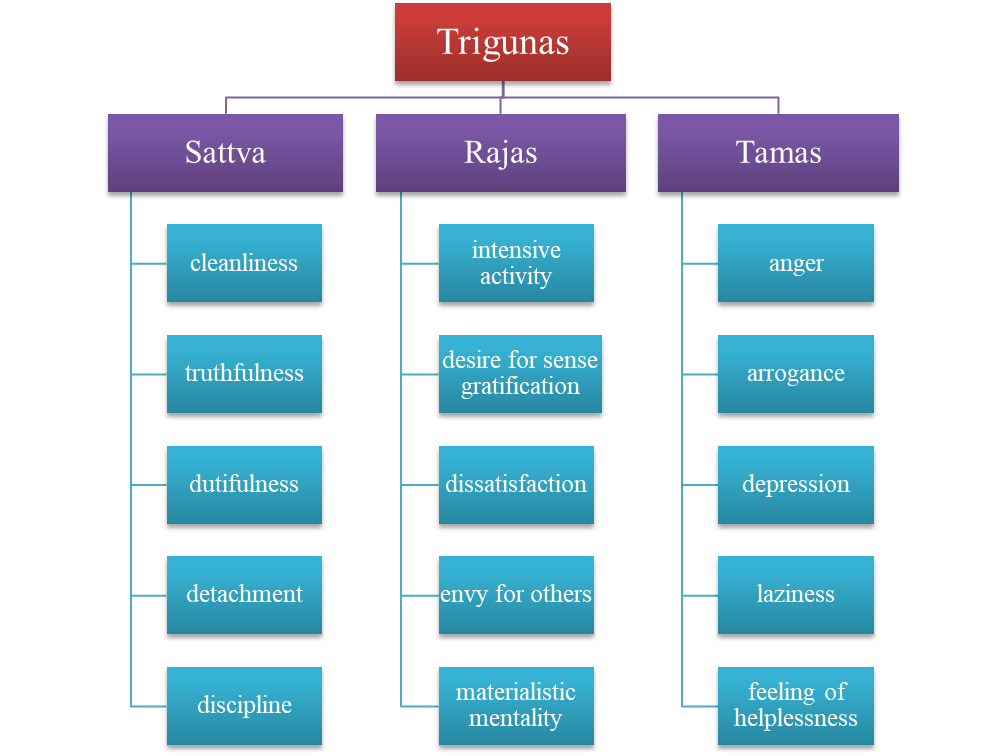
All the three gunas are present in each and every person in different degrees.
- The dominance of one or the other guna may lead to a particular type of behaviour.
- Typology by grouping people into Introverts and Extraverts by Jung

- Typology using Body Build and Temperament by Sheldon
- Typology – Type A, Type B, Type C and Type D
- Friedman and Rosenman classified individuals into Type A and Type B.
- This typology was further extended by Morris who suggested Type C personality.
- More recently, a Type D personality has been suggested.
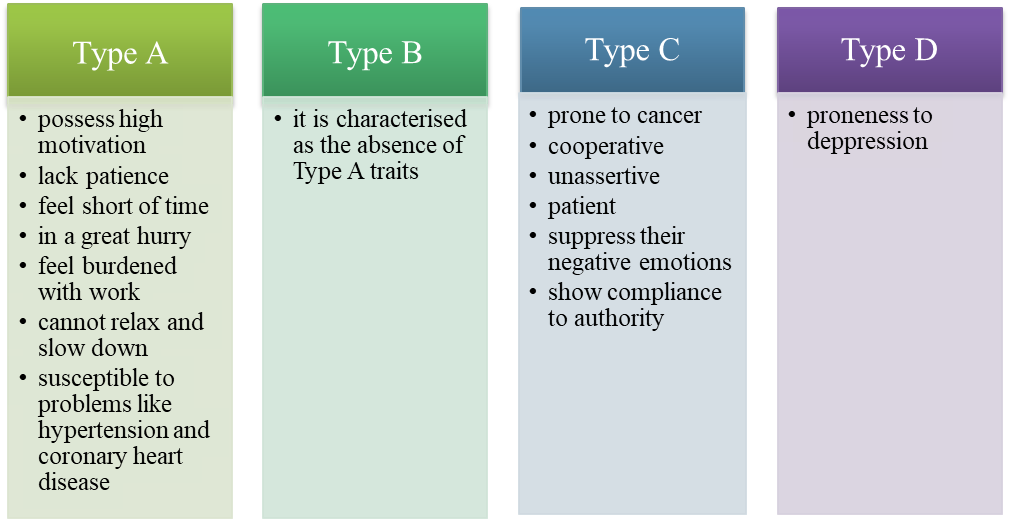
Trait Approach
- The trait approach focuses on the specific psychological attributes along which individuals tend to differ in consistent and stable ways.
- An approach to personality that seeks to identify the basic traits necessary to describe personality.
- It tries to discover the ‘building blocks’ of personality.
- It attempts to identify primary characteristics of people.
- Traits are:
- relatively stable over time
- generally consistent across situations
- their strengths and combinations vary across individuals leading to individual differences in personality
1) Cattell: Personality Factors
- Raymond Cattell believed that there is a common structure on which people differ from each other.
- This structure could be determined empirically.
- He tried to identify the primary traits from a huge array of descriptive adjectives found in language.
- He applied a statistical technique, called factor analysis, to discover the common structures.
- He found 16 primary or source traits which are stable, and are considered as the building blocks of personality. Cattell described the source traits in terms of opposing tendencies.
- There are also a number of surface traits that result out of the interaction of source traits.
- He developed a test, called Sixteen Personality Factor Questionnaire (16PF), for the assessment of personality which is widely used by psychologists.
2) Allport’s Trait Theory
- Gordon Allport is considered the pioneer of trait approach.
- He proposed that individuals possess a number of traits that:
- are dynamic in nature
- determine behaviour in such a manner that an individual approaches different situations with similar plans
- integrate stimuli and responses which otherwise look dissimilar
- Allport argued that the words people use to describe themselves and others provide a basis for understanding human personality. Therefore, he analysed the words of English language to look for traits which describe a person.
- Allport categorised traits into:
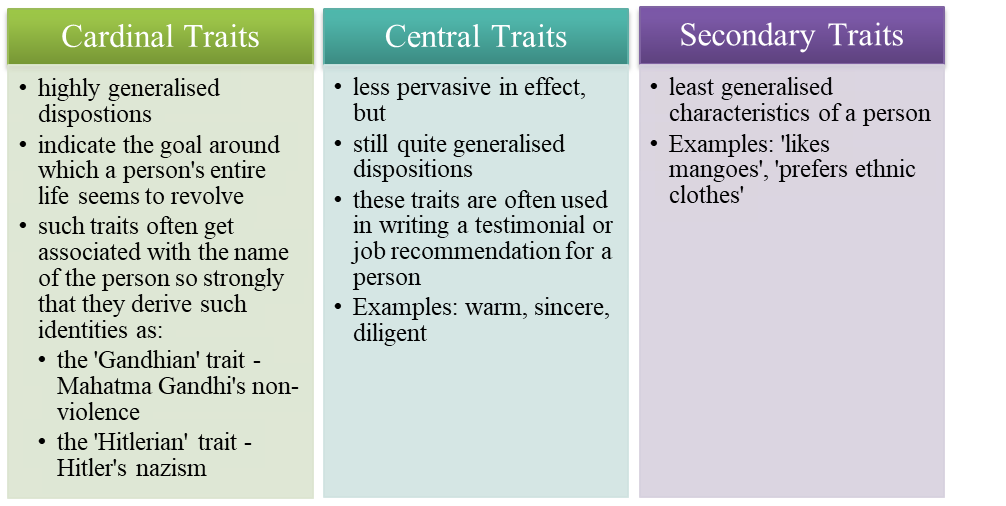
- Allport believed that the way a person reacts to given situations depends on her/his traits, although people sharing the same traits might express them in different ways.
- He considered traits more like intervening variables that occur between the stimulus situation and response of the person. This meant that any variation in traits would elicit a different response to the same situation.
3) Eysenck’s Theory
- H.J. Eysenck proposed that personality could be reduced into two broad dimensions that are biologically and genetically based.
- Each dimension subsumes a number of specific traits. These dimensions are:
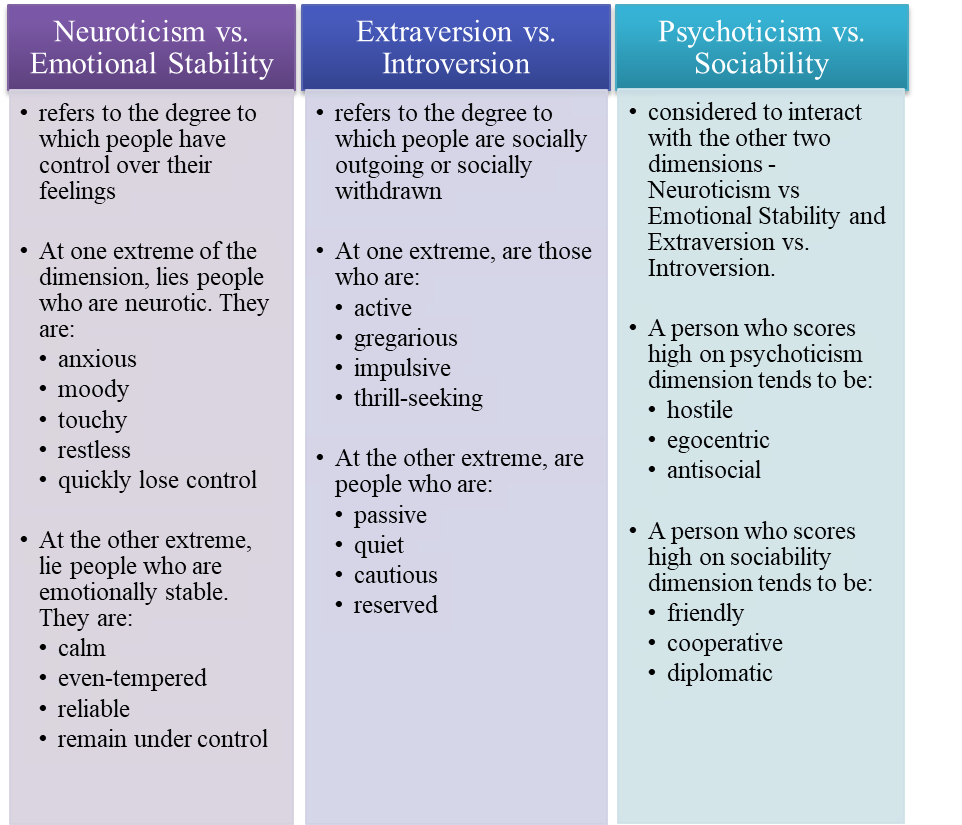
- Eysenck Personality Questionnaire is the test which is used for studying these dimensions of personality.
Interactional Approach
- It believes situational characteristics play an important role in determining our behaviour.
- People may behave as dependent or independent not because of their internal personality trait, but because of external rewards or threats available in a particular situation.
- The crosssituational consistency of traits is found to be quite low.
- The compelling influence of situations can be noted by observing people’s behaviour in places like a market, a courtroom, or a place of worship.
Five-Factor Model of Personality
- Paul Costa and Robert McCrae formulated a Big Five Factor Model of Personality indicating a set of five personality traits. They are often called Big Five Factors, also abbreviated as ‘OCEAN’. These factors include:
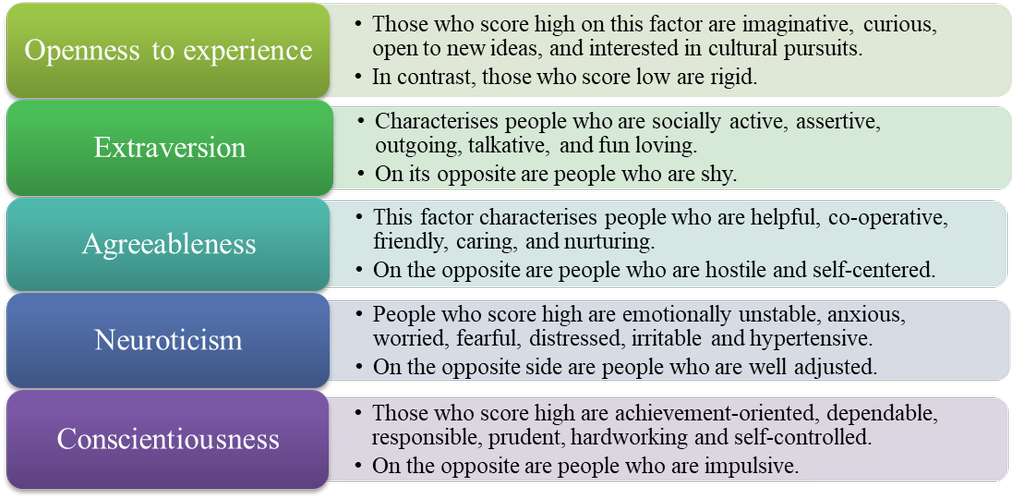
- Significance of Five-Factor Model of Personality
- an important theoretical development in the field of personality.
- useful in understanding the personality profile of people across cultures.
- considered to be the most promising empirical approach to the study of personality.
- consistent with the analysis of personality traits found in different languages.
- supported by the studies of personality carried out through different methods.
Psychodynamic Approach
- Proposed by Sigmund Freud, a physician, who developed this theory in the course of his clinical practice.
- Early in his career he used hypnosis to treat people with physical and emotional problems.
- He noted that many of his patients needed to talk about their problems, and having talked about them, they often felt better.
- Freud used:
- Free association, a method in which a person is asked to openly share all the thoughts, feelings and ideas that come to her/his mind
- Dream analysis
- Analysis of errors to understand the internal functioning of the mind
1) Levels of Consciousness
- Freud’s theory considers the sources and consequences of emotional conflicts and the way people deal with these.
- And it visualises the human mind in terms of three levels of consciousness:
Conscious
- includes the thoughts, feelings and actions of which people are aware.
Preconscious
- includes mental activity of which people may become aware only if they attend to it closely.
Unconscious
a) includes mental activity that people are unaware of.
b) reservoir of instinctive or animal drives.
c) stores all ideas and wishes that are concealed from conscious awareness, perhaps, because they lead to psychological conflicts. And most of these arise from sexual desires which cannot be expressed openly and therefore are repressed.
- People constantly struggle to find either some socially acceptable ways to express unconscious impulses, or to keep those impulses away from being expressed.
- Unsuccessful resolution of conflicts results in abnormal behaviour.
- Analysis of forgetting, mispronunciations, jokes and dreams provide us with a means to approach the unconscious.
- Freud developed a therapeutic procedure, called psychoanalysis.
- The basic goal of psychoanalytic therapy is to bring the repressed unconscious materials to consciousness, thereby helping people to live in a more self-aware and integrated manner.
2) Structure of Personality
- According to Freud’s theory, the primary structural elements of personality are three, i.e. id, ego, and superego.
- They reside in the unconscious as forces, and they can be inferred from the ways people behave.
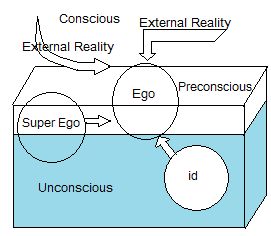
Structure of Personality in Freudian Theory
Id
a) the source of a person’s instinctual energy
b) deals with immediate gratification of primitive needs, sexual desires and aggressive impulses
c) works on the pleasure principle (based on the assumption that people seek pleasure and try to avoid pain)
d) Freud considered much of a person’s instinctual energy to be sexual, and the rest as aggressive
e) does not care for moral values, society, or other individuals
f) demanding
g) unrealistic
Ego
a) grows out of id
b) seeks to satisfy an individual’s instinctual needs in accordance with reality
c) works by the reality principle
d) directs the id towards more appropriate ways of behaving
e) patient
f) reasonable
Superego
a) moral branch of mental functioning
b) tells the id and the ego whether gratification in a particular instance is ethical
c) helps control the id by internalising the parental authority through the process of socialisation
d) does not create guilt, fear or anxiety
- The relative strength of the id, ego and superego determines each person’s stability.
- Freud also assumed that id is energised by two instinctual forces, called life instinct (also called sexual instinct) and death instinct.
- He paid less attention to the death instinct and focused more on the life (or sexual) instinct.
- The instinctual life force that energises the id is called libido. It works on the pleasure principle, and seeks immediate gratification.
Ego Defence Mechanisms
- According to Freud, much of human behaviour reflects an attempt to deal with or escape from anxiety.
- Thus, how the ego deals with anxiety largely determines how people behave.
- Freud believed that people avoid anxiety mainly by developing defence mechanisms that try to defend the ego against the awareness of the instinctual needs.
- Thus, defence mechanism is a way of reducing anxiety by distorting reality.
- People who use these mechanisms to such an extent that reality is truly distorted develop various forms of maladjustment.
- People who use defence mechanisms are often unaware of doing so.
- Each defence mechanism is a way for the ego to deal with the uncomfortable feelings produced by anxiety.
- Various kinds of defence mechanisms are:
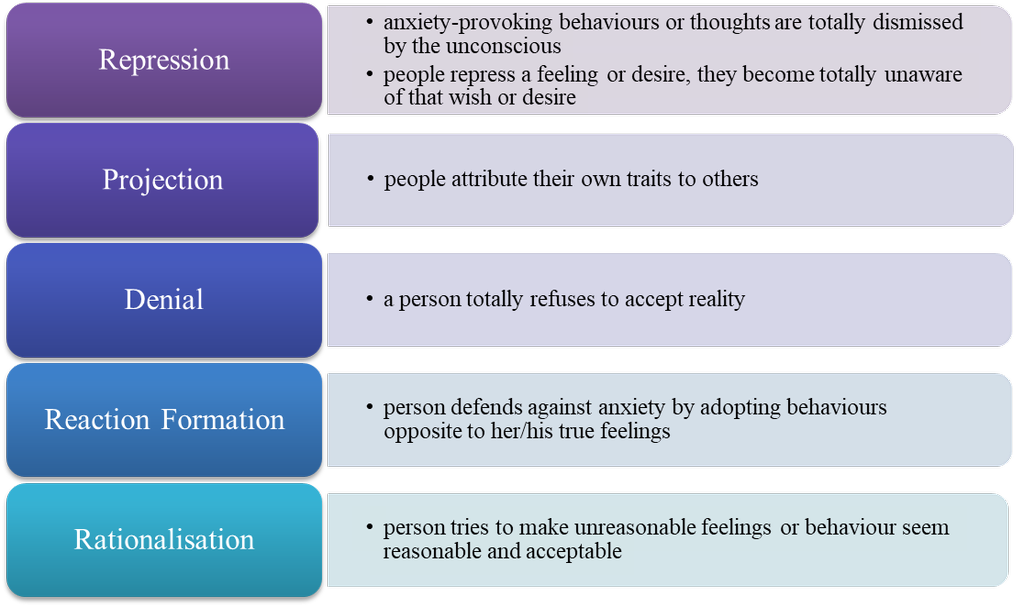
Stages of Personality Development
- Freud proposed a five-stage theory of personality (also called psychosexual) development.
- Problems encountered at any stage may arrest development, and have long-term effect on a person’s life.
- The stages of psychosexual development are:
Oral Stage
- A newborn’s instincts are focused on the mouth i.e. infant’s primary pleasure seeking centre.
- It is through the mouth that the baby obtains food that reduces hunger.
- The infant achieves oral gratification through feeding, thumb sucking, biting and babbling.
- People’s basic feelings about the world are established.
Anal Stage (around ages two and three)
- Child learns to respond to some of the demands of the society.
- One of the principal demands made by parents is that the child learns to control the bodily functions of urination and defecation.
- Children experience pleasure in moving their bowels.
- The anal area of the body becomes the focus of certain pleasurable feelings.
- Establishes the basis for conflict between the id and the ego, and between the desire for babyish pleasure and demand for adult, controlled behaviour.
Phallic Stage (around ages four and five)
- Focuses on the genitals.
- Children begin to realise the differences between males and females.
- They become aware of sexuality and the sexual relationship between their parents.
- In this stage, the male child experiences Oedipus Complex, which involves:
- love for the mother
- hostility towards the father
- consequent fear of punishment or castration by the father
A major developmental achievement of this stage is the resolution of the Oedipus complex which takes place by:
- accepting his father’s relationship with his mother
- modelling his own behaviour after his father
- give up sexual feelings for their mothers
- begin to see their fathers as role models rather than as rivals
- In this stage, the female child experiences Electra Complex, which involves:
- attaching her love to the father
- trying to symbolically marry him and raise a family
When she realises that this is unlikely, she begins to:
- identify with her mother
- copy her behaviour as a means of getting her father’s affection
Resolution of the Electra complex takes place by:
- giving up their sexual feelings or desires for their fathers
- identifying with their mother
- The critical component in resolving the Oedipus complex is the development of identification with the same sex parents.
Latency Stage (lasts from about 7 years until puberty)
- The child continues to grow physically.
- Sexual urges are relatively inactive.
- Much of a child’s energy is channelled into social or achievement-related activities.
Genital Stage
- The person attains maturity in psychosexual development.
- The sexuality, fears and repressed feelings of earlier stages are once again exhibited.
- People learn to deal with members of the opposite sex in a socially and sexually mature way.
- However, if the journey towards this stage is marked by excessive stress or over-indulgence, it may cause fixation to an earlier stage of development.
Fixation
- Failure of a child to pass successfully through a stage leads to fixation to that stage.
Regression
- It takes a person back to an earlier stage.
- It occurs when a person’s resolution of problems at any stage of development is less than adequate.
- In this situation, people display behaviours typical of a less mature stage of development.
Criticisms of Psychodynamic theories:
- The theories are largely based on case studies; they lack a rigorous scientific basis.
- They use small and atypical individuals as samples for advancing generalisations.
- The concepts are not properly defined, and it is difficult to submit them to scientific testing.
- Freud has used males as the prototype of all human personality development. He overlooked female experiences and perspectives.
Post-Freudian Approaches/ Neo Analytic
- Characterised by less prominent roles to sexual and aggressive tendencies of the id
- Expansion of the concept of ego
- Emphasis on the human qualities of creativity, competence, and problem solving abilities
Carl Jung: Aims and Aspirations
- Humans are guided as much by aims and aspirations as by sex and aggression.
- Developed his own theory of personality, called analytical psychology.
The basic assumption of his theory is that personality consists of competing forces and structures within the individual (that must be balanced) rather than between the individual and the demands of society, or between the individual and reality.
- Jung claimed that there was a collective unconscious consisting of archetypes or primordial images, which are not individually acquired, but are inherited. Example - The God or the Mother Earth. They are found in myths, dreams and arts of all mankind.
- Jung held that the self strives for unity and oneness. According to him, for achieving unity and wholeness, a person must become increasingly aware of the wisdom available in one’s personal and collective unconscious, and must learn to live in harmony with it.
Karen Horney: Optimism
- Adopted a more optimistic view of human life with emphasis on human growth and self-actualisation.
- Major contribution lies in her challenge to Freud’s treatment of women as inferior.
- According to her, each sex has attributes to be admired by the other, and neither sex can be viewed as superior or inferior.
- She countered that women were more likely to be affected by social and cultural factors than by biological factors.
- She argued that psychological disorders were caused by disturbed interpersonal relationship during childhood.
- When parents’ behaviour toward a child is indifferent, discouraging, and erratic, the child feels insecure and a feeling called basic anxiety results.
- Deep resentment toward parents or basic hostility occurs due to this anxiety.
- By showing excessive dominance or indifference, or by providing too much or too little approval, parents can generate among children feelings of isolation and helplessness which interfere with their healthy development.
Alfred Adler: Lifestyle and Social Interest
- Adler’s theory is known as individual psychology.
- His basic assumption is that human behaviour is purposeful and goal-directed.
- Each one of us has the capacity to choose and create.
- Our personal goals are the sources of our motivation.
- The goals that provide us with security and help us in overcoming the feelings of inadequacy are important in our personality development.
- In Adler’s view, every individual suffers from the feelings of inadequacy and guilt, i.e. inferiority complex, which arise from childhood.
- Overcoming this complex is essential for optimal personality development.
Erich Fromm: The Human Concerns
- Developed his theory from a social orientation.
- Viewed human beings as basically social beings who could be understood in terms of their relationship with others.
- Psychological qualities such as growth and realisation of potentials resulted from a desire for freedom, and striving for justice and truth.
- Character traits (personality) develop from our experiences with other individuals.
- While culture is shaped by the mode of existence of a given society, people’s dominant character traits in a given society work as forces in shaping the social processes and the culture itself.
- His work recognises the value of positive qualities, such as tenderness and love in personality development.
Erik Erikson: Search for Identity
- Emphasises on rational, conscious ego processes in personality development.
- Development is viewed as a lifelong process, and ego identity is granted a central place in this process.
- His concept of identity crisis of adolescent age has drawn considerable attention.
- Erikson argues that young people must generate for themselves a central perspective and a direction that can give them a meaningful sense of unity and purpose.
Behavioural Approach
- This approach does not give importance to the internal dynamics of behaviour.
- The behaviourists believe in data, which they feel are definable, observable, and measurable.
- They focus on learning of stimulus-response connections and their reinforcement.
- According to them, personality can be best understood as the response of an individual to the environment.
- They see the development simply as a change in response characteristics, i.e. a person learns new behaviours in response to new environments and stimuli.
- The structural unit of personality is the response.
- Each response is a behaviour, which is emitted to satisfy a specific need.
- The core tendency that organises behaviour is the reduction of biological or social needs that energise behaviour.
This is accomplished through responses (behaviours) that are reinforced.
- The principles of theories of learning (classical conditioning, instrumental conditioning, and observational learning) have been widely used in developing personality theories.
For example:
- Observational learning theory considers thought processes extremely important in learning, but these find almost no place in classical or instrumental conditioning theories.
- Observational learning theory also emphasises social learning (based on observation and imitation of others) and self-regulation, which again is missed out in other theories.
Cultural Approach
- Attempts to understand personality in relation to the features of ecological and cultural environment.
- Proposes that a group’s ‘economic maintenance system’ plays a vital role in the origin of cultural and behavioural variations.
- People’s skills, abilities, behavioural styles, and value priorities are viewed as strongly linked to the features such as settlement patterns, social structures, division of labour, child rearing practices, etc.
- Rituals, ceremonies, religious practices, arts, recreational activities, games and play are the means through which people’s personality gets projected in a culture.
- People develop various personality (behavioural) qualities in an attempt to adapt to the ecological and cultural features of a group’s life.
- The cultural approach considers personality as an adaptation of individuals or groups to the demands of their ecology and culture.
Humanistic Approach (in response to Freud’s theory)
Carl Rogers’ Contribution to the Development of Humanistic Perspective on Personality:
- The most important idea proposed by Rogers is that of a fully functioning person.
He believes that fulfilment is the motivating force for personality development.
People try to express their capabilities, potentials and talents to the fullest extent possible.
There is an inborn tendency among persons that directs them to actualise their inherited nature.
- Rogers makes two basic assumptions about human behaviour.
- Behaviour is goal-directed and worthwhile.
- People (who are innately good) will almost always choose adaptive, self-actualising behaviour.
- His theory is structured around the concept of self.
The theory assumes that people are constantly engaged in the process of actualising their true self.
Rogers suggests that each person also has a concept of ideal self i.e. the self that a person would like to be.
When there is a correspondence between the real self and ideal self, a person is generally happy. Discrepancy between the real self and ideal self often results in unhappiness and dissatisfaction. Rogers’ basic principle is that people have a tendency to maximise self-concept through self-actualisation.
In this process, the self grows, expands and becomes more social.
- Rogers views personality development as a continuous process which involves learning to evaluate oneself and mastering the process of self-actualisation.
He recognises the role of social influences in the development of self-concept.
When social conditions are positive, the self-concept and self-esteem are high.
In contrast, when the conditions are negative, the self-concept and self-esteem are low.
People with high self-concept and self-esteem are generally flexible and open to new experiences, so that they can continue to grow and self-actualise.
- This situation warrants that an atmosphere of unconditional positive regard must be created in order to ensure enhancement of people’s self-concept.
The client-centred therapy that Rogers developed basically attempts to create this condition.
Abraham Maslow’s Contribution to the Development of Humanistic Perspective on Personality:
- Maslow has given a detailed account of psychologically healthy people in terms of their attainment of self-actualisation, a state in which people have reached their own fullest potential.
- He had an optimistic and positive view of man who has the potentialities for love, joy and to do creative work.
- Human beings are considered free to shape their lives and to self-actualise.
- Self-actualisation becomes possible by analysing the motivations that govern our life.
- An individual’s sole concern with the satisfaction of survival needs (biological, security, and belongingness needs) reduces her/ him to the level of animals.
- The real journey of human life begins with the pursuit of self-esteem and selfactualisation needs.
- The humanistic approach emphasises the significance of positive aspects of life.

Characteristics of a healthy person according to humanistic theorists:
- They become aware of themselves, their feelings, and their limits; accept themselves, and what they make of their lives as their own responsibility; have ‘the courage to be’.
- They experience the “here-and-now”; are not trapped.
- They do not live in the past or dwell in the future through anxious expectations and distorted defences.

 PathSet Publications
PathSet Publications
